Contents
Market Overview
Macro Review
Payers, steepeners and inflation remain in focus. The 10yr U.S. Treasury is now almost 45bp wider in 2021, with 10yr real yields at -77bp, which reflects a 27bp move in the past week. Curves remain steep and close to 4yr wides as 2s30s moved above 200bp, while 2s10s is as steep as 123bp. Equities clung on and ended the week virtually unchanged, but as a growing debate surrounds the cyclical rotation, U.S. banks still outperformed on higher rates. Elsewhere, CNH wobbled on Sino-US tensions as China mulls limiting exports of rare earth minerals while the PBoC continues to withdraw liquidity after Lunar New Year. A slew of EM countries also reported solid 4Q GDP as Colombia, Hungary, Israel and Romania posted large beats. Crude oil may have traded soft in the latter part of the week, although remains comfortably above $60/bbl, which did not re-price meaningfully on Saudi Arabian supply, prospects of U.S.-Iran dialogue or restored output out of Texas.
EM Credit Update
EM Corporates significantly outperformed EM Sovereigns this week. At the sovereign level, Zambia, Suriname and Papua New Guinea outperformed this week, while Lebanon, Sri Lanka and Ethiopia lagged.
As we identify the outperformance, we note that EM Corporate Credit is now 20bp tighter, while EM Sovereign Credit is only 5bp tighter this year. Most of the spread tightening comes as rates have sold-off, but sector outperformance in oil and metals helped. EM has also considerably outperformed U.S. IG and U.S. HY. So far in 2021, returns in EM Corporate HY are on par with U.S. HY (up 1.4%), but credit spreads have done considerably better in EM over U.S. credit (8bp of outperformance). We have also seen EM Corporate HY outperform U.S. IG where the return differential stands at 2.5ppts now (U.S. IG is down 1.1% year-to-date).
The Week Ahead
Into next week, rate decisions dominate the calendar from China (3.85%), Israel (0.1%), Hungary (0.6%) and South Korea (0.5%). Banxico minutes may become a relevant fixture given the 25bp cut, although Brazil’s inflation print may offer some insight when it comes to the first EM central bank hiking rates (unless its Russia). Otherwise, inflation releases are mostly concentrated in Asia from Hong Kong, Malaysia and Singapore. Beyond that its over to GDP which has broadly surprised to the upside with India and Poland in focus. Finally, Turkey are due to update trade balance data, which becomes relevant after the CBRT held rates at 17% but hawkish commentary ensured TRY was a top EMFX performer (after the Chilean peso).
This week’s emerging markets highlights discussed below include the following: Potential increase in the IMF’s Special Drawing Rights (SDRs) will be credit positive for EM, especially for economies facing external liquidity pressures; mixed headlines on Argentina’s pathway to a new IMF arrangement; El Salvador’s parliamentary elections on February 28th could pave the way to an IMF program .
Fixed Income
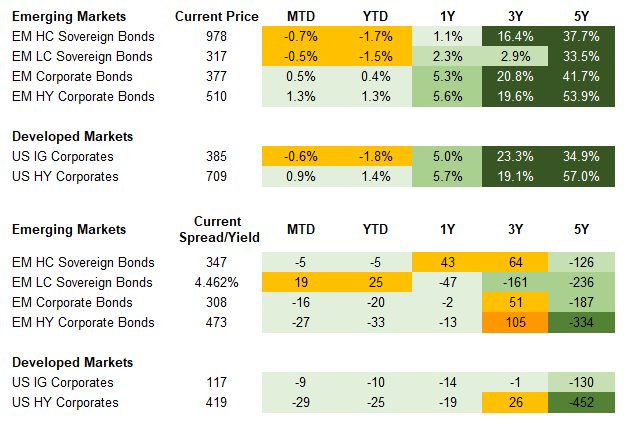
Equities
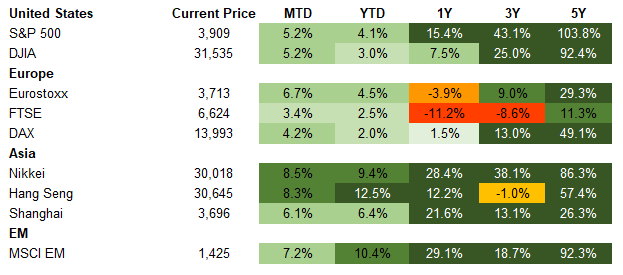
Commodities

Source for data tables: Bloomberg, JPMorgan, Gramercy. EM Fixed Income is represented by the following JPMorgan Indicies: EMBI Global, GBI-EM Global Diversified, CEMBI Broad Diversified and CEMBI Broad High Yield. DM Fixed Income is represented by the JPMorgan JULI Total Return Index and Domestic High Yield Index. Fixed Income, Equity and Commodity data is as of February 19, 2021 (Mid Afternoon).
Emerging Markets Weekly Highlights
Potential increase in the IMF’s Special Drawing Rights (SDRs) will be credit positive for EM, especially for economies facing external liquidity pressures
Event: There have been increasingly strong signals recently that a possible new allocation of SDRs, the IMF’s unit of account and international reserve asset, could be forthcoming as soon as 2Q21. The U.S. government, whose position is key as the IMF’s largest stakeholder, appears to be supportive of the plan. The IMF’s leadership has proposed to increase SDRs as a way to support access to hard currency liquidity by its members, especially vulnerable developing economies that do not benefit directly from QE measures by the systemic central banks.
Gramercy Commentary: The rumored size of the potential increase is around $500bn, a level for which the Biden Administration is not required to seek congressional approval. If the plan goes forward, all IMF member countries will receive additional SDRs from this amount proportional to their IMF quotas. Our understanding is that a possible “re-allocation” of existing SDRs from DM to EM is also being discussed, which will provide an additional benefit to EM if it happens. SDRs are an international reserve asset created by the IMF in 1969 to supplement its member countries’ official reserves. At present, SDR 204.2bn (equivalent to ~$300bn) have been allocated to members, including SDR 182.6bn allocated in 2009 in the wake of the global financial crisis. As such, a new allocation of around $500mn, or close to SDR 350bn, will be almost two times that size, increasing the pool of available SDRs to ~$800bn. The IMF issues SDRs to the central banks of its members as a reserve asset that they can easily exchange for hard currency at a low interest rate, usually < 1% per annum. From that perspective, SDRs are most impactful for IMF members that face external liquidity pressures. They allow on-demand access to freely usable hard currency, thus playing an important role in providing affordable FX liquidity to EM economies. If the increase in SDRs goes through, according to our calculations, the countries included in the JPM EMBI Global will see a 1% of GDP increase in their FX reserves, on average. High yield sovereign issuers with significant market relevance such as Ecuador, Sri Lanka, El Salvador, Bahrain, Ghana, Turkey, Argentina and Ukraine will be among those that will see relatively larger improvements in their external liquidity positions. The largest EM economies that have more sizable IMF quotas will see significant nominal increases in FX reserves: India (13.8bn), Russia (13.6bn), Brazil (11.6bn), Saudi Arabia (10.5bn), Mexico (9.4bn), Turkey (4.9bn), Indonesia (4.9bn), and South Africa (3.2bn), among others.
Mixed headlines on Argentina’s pathway to a new IMF arrangement
Event: Argentine IMF representative, Sergio Chodos, indicated that a swift deal is less relevant and proper assessment and strategy to resolve the country’s problems is of greatest importance, while IMF Western Hemisphere Chief, Alejandro Werner, described a deal by May as ambitious. Local reports indicated that a 60-day grace period on the $2.4bn Paris Club payment in May could provide room for longer negotiations. Meanwhile, the Exchange Bondholder Group issued a statement on Argentina’s economic policy emphasizing the importance of a detailed macroeconomic agenda and an IMF deal that allows Argentina to rebuild FX reserves and restore confidence.
Gramercy Commentary: We continue to expect a deal to be reached with the IMF albeit recognize the political and economic nuances regarding risks to timing. The currently supportive external backdrop combined with prospects for an additional SDR allocation in April should limit near term FX market and bond price pressure despite growing potential for more prolonged dialogue than previously envisaged. The policy agenda and associated growth and FX reserve recovery prospects underpinning the ultimate IMF program combined with the implications of interim policy management as well as the timing and outcome of the mid-term elections should determine the scope and durability of asset price recovery post announcement of a deal.
El Salvador’s parliamentary elections on February 28th could pave the way to an IMF program
Event: El Salvador is heading into parliamentary elections on February 28. President Nayib Bukele’s Nuevas Ideas (NI) party is likely to win a solid majority in the 84 seat Legislative Assembly, consolidating Bukele’s grip on power.
Gramercy Commentary: The political environment that will emerge from the upcoming elections will delineate the budget consolidation path by the government in 2H21 to ensure fiscal sustainability within the confines of a dollarized economy. The authorities unleashed a sizable fiscal stimulus to support the economy last year and now need to gradually unwind it in order to tackle the public sector’s large funding needs and deteriorating debt metrics. Having at least a simple majority in the Assembly will help President Bukele and his Administration in advancing and implementing economic policy. With approval ratings around 90%, Mr. Bukele is among the most popular heads of state globally, but has until now operated as a leader of a minority government, given limited NI representation in the outgoing parliament. Once election uncertainty is behind us, a strengthened Bukele Administration might be in a good position to anchor the fiscal adjustment around a funded IMF program with specific targets and conditionality. That would be a credit positive development that significantly boosts investor confidence, in our view. The IMF’s revealed preference for flexibility, demonstrated in its relationships with regional peers such as Ecuador and Costa Rica, should also be an important decision factor for the government when weighing the pros and cons of an assistance package by the Fund. Regardless of whether or not El Salvador signs up to an IMF program, the authorities face incentive to deliver fiscal tightening in 2021-22 in order to ensure market access ahead of next year when they have to refinance an $800mn Eurobond maturing in early 2023.
Emerging Markets Technicals
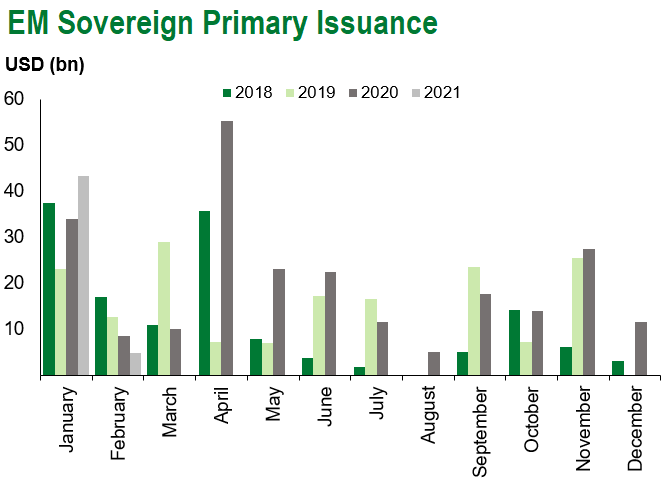
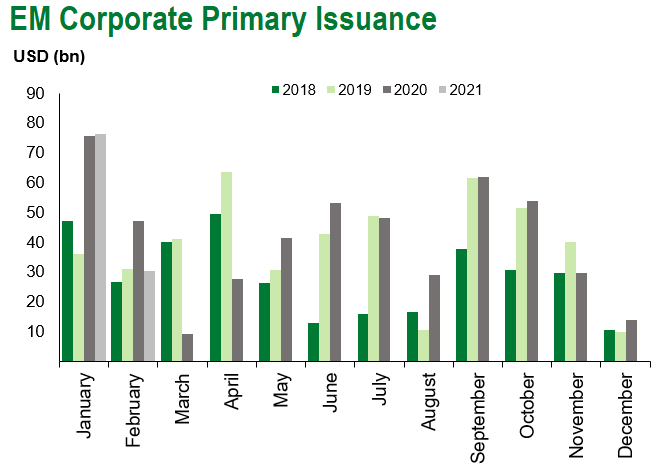
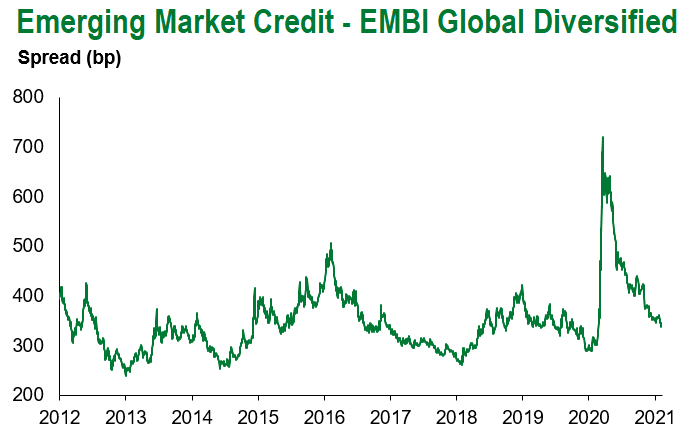
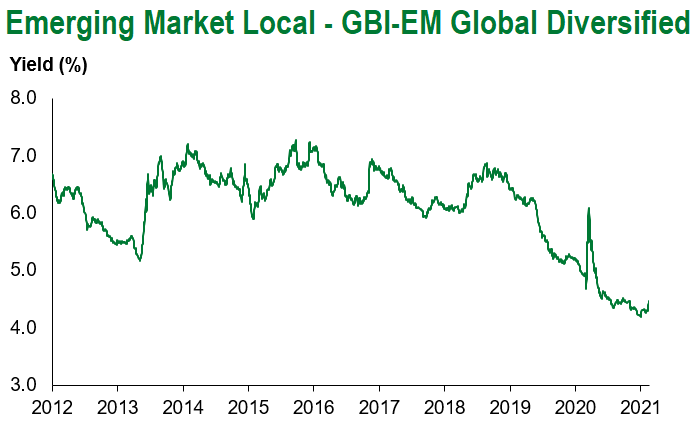
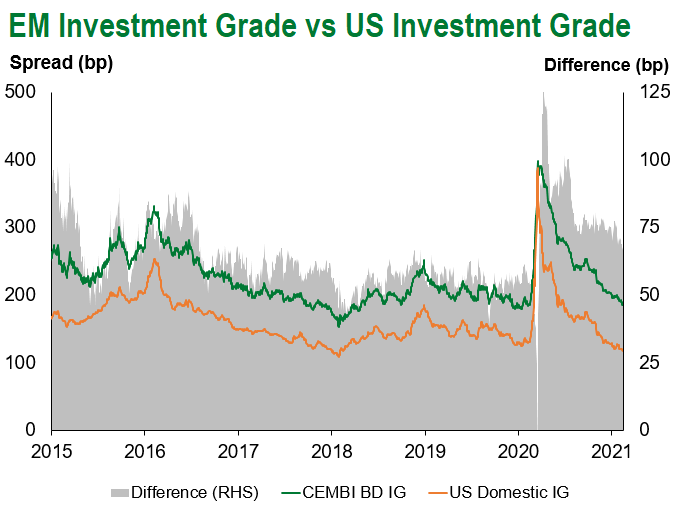
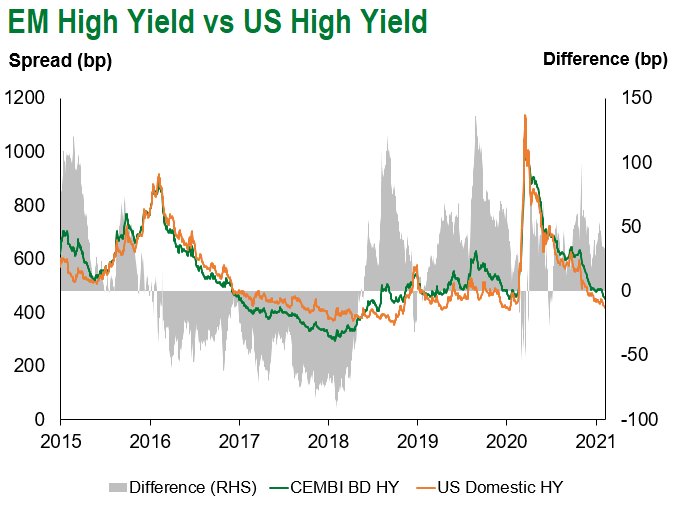
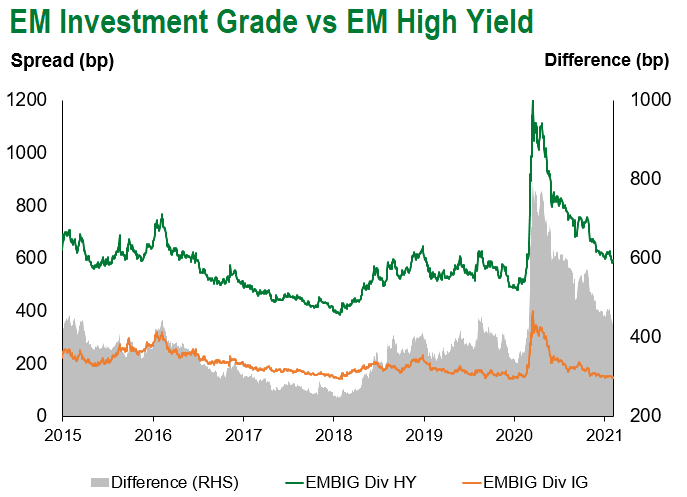
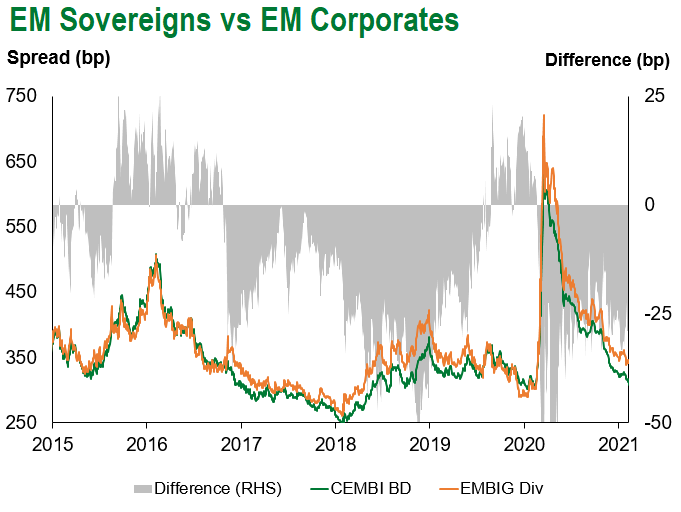
Emerging Markets Flows
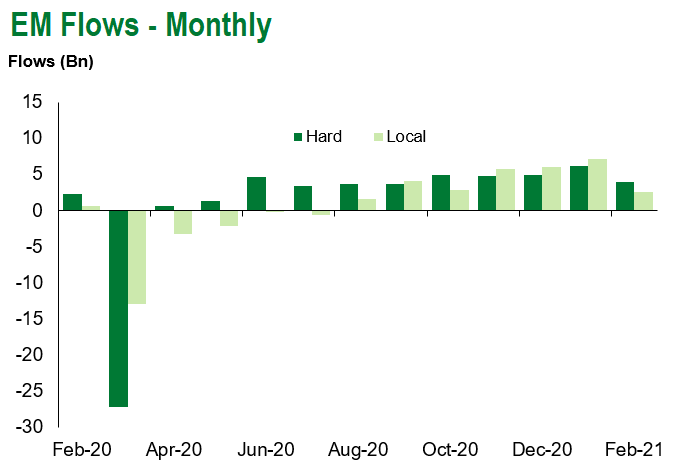
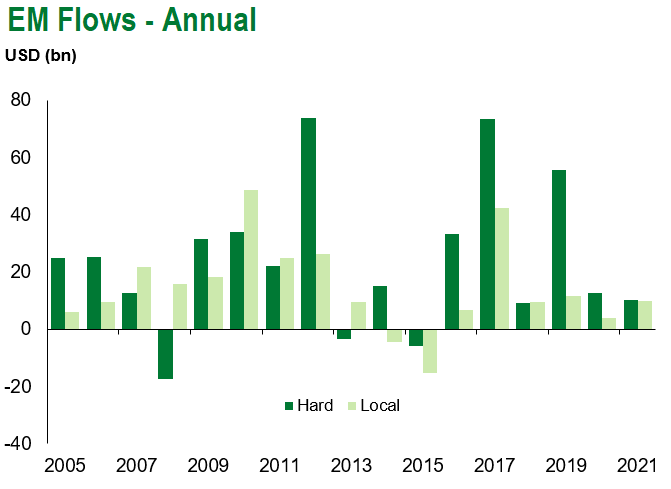
Source for graphs: Bloomberg, JPMorgan, Gramercy. As of February 19, 2021.
COVID Resources
Emerging Markets COVID-19 Case Summary
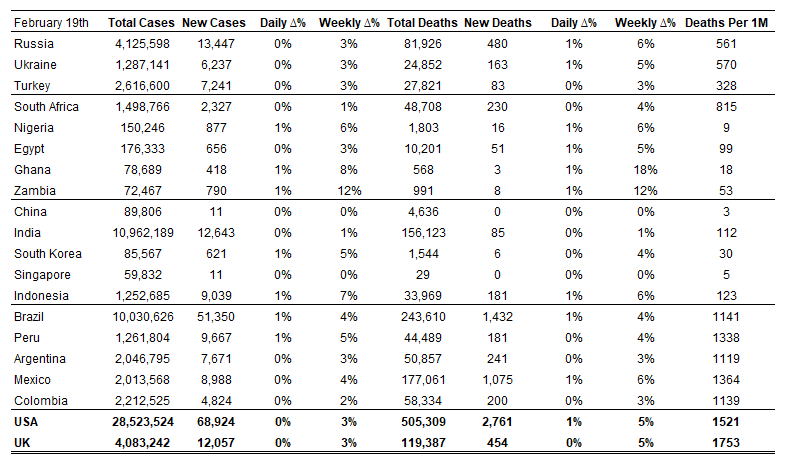
Source: Worldometer as of February 19, 2021.
Additional Crisis Resources:
Johns Hopkins COVID-19 Case Tracker
For questions, please contact:
Kathryn Exum, Senior Vice President, Sovereign Research Analyst, [email protected]
Petar Atanasov, Senior Vice President, Sovereign Research Analyst, [email protected]
Tolu Alamutu,CFA, Senior Vice President, Corporate Research Analyst, [email protected]
James Barry, Vice President, Corporate Research Analyst, [email protected]
This document is for informational purposes only. The information presented is not intended to be relied upon as a forecast, research or investment advice, and is not a recommendation, offer or solicitation to buy or sell any securities or to adopt any investment strategy. Gramercy may have current investment positions in the securities or sovereigns mentioned above. The information and opinions contained in this paper are as of the date of initial publication, derived from proprietary and nonproprietary sources deemed by Gramercy to be reliable, are not necessarily all-inclusive and are not guaranteed as to accuracy. This paper may contain “forward-looking” information that is not purely historical in nature. Such information may include, among other things, projections and forecasts. There is no guarantee that any forecasts made will come to pass. Reliance upon information in this paper is at the sole discretion of the reader. You should not rely on this presentation as the basis upon which to make an investment decision. Investment involves risk. There can be no assurance that investment objectives will be achieved. Investors must be prepared to bear the risk of a total loss of their investment. These risks are often heightened for investments in emerging/developing markets or smaller capital markets. International investing involves risks, including risks related to foreign currency, limited liquidity, less government regulation, and the possibility of substantial volatility due to adverse political, economic or other developments. The information provided herein is neither tax nor legal advice. Investors should speak to their tax professional for specific information regarding their tax situation.